You are currently browsing the category archive for the ‘Film’ category.
EXCERPT:
By Joyce Sáenz Harris
Even for fans who are well-acquainted with the work of Dallas native Stephen Tobolowsky, his new book, My Adventures with God, is a bit of a surprise: an exploration of his midlife return to the Jewish faith.
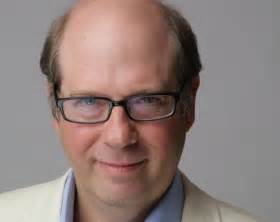

PHOTO: Jim Britt
Tobolowsky is a graduate of Justin F. Kimball High School and Southern Methodist University. In the past three decades, he has become a beloved character actor who displays both comedy and drama chops in more than 100 films as diverse as Groundhog Day and Mississippi Burning. He’s been on more than 200 TV shows ranging from Deadwood to Glee, most recently Silicon Valley and The Goldbergs. He also tells stories on the popular podcast The Tobolowsky Files.
Tobolowsky, who lives in Los Angeles, will return to his hometown to celebrate the publication of My Adventures With God (Simon & Schuster, $25) on Tuesday, April 18, with an appearance at the Dallas Museum of Art as part of Arts & Letters Live. He answered questions by email; here are highlights.
Like your 2012 book The Dangerous Animals Club, My Adventures with God is a memoir with a lot of Dallas and many laugh-out-loud moments. But the spiritual aspect often takes it into a more serious realm.
Simon and Schuster asked me if I could write a book on faith. When I was grasping for a premise for My Adventures with God, I came up with something that turned out to be truer than I first imagined: Our lives often fit the template of the Pentateuch, the first five books of the Old Testament.
We all have a Genesis. This is usually what we talk about on a first date: who we are, where we came from, our aspirations. Then, like in Exodus, we go into slavery. Instead of building pyramids, we lose ourselves in the desperation of first loves, first jobs. Some are trapped by drugs and alcohol, others by graduate school.
Then we escape and have our Leviticus moment. We stop and say, “This is what I am.” This is when I married Ann. When I became a father. When I returned to Judaism. Then we are shaped by mortality, as in the Book of Numbers, as we lose family and friends. And finally, we get to a place of perspective: Deuteronomy. It is here when we tell our stories to our children and try to make sense of the journey.
You were in seventh grade when President John F. Kennedy was assassinated in Dallas, and you write that “for those few days, history pulled back the curtain and showed us all how close we are to the edge of nothing.” Have you had any other occasions like that, such as 9/11?
Once you are aware of how delicate civilization is, you see its potential downfall everywhere. Usually in lies. They can be big lies from people in power — or the lies we tell ourselves. It doesn’t take anything as cataclysmic as 9/11. As my mother said, “Don’t break your word. You only get one. When you break it, it’s hard to get it back again.”
For the rest of the story, visit:
https://www.dallasnews.com/arts/books/2017/04/12/dallas-stephen-tobolowsky-faith-new-book-everyones-old-testament-lives
By JOYCE SÁENZ HARRIS
Special Contributor
Published: 13 July 2015 10:48 AM
When last we saw young Scout Finch of Maycomb, Ala., it was 1935. Scout had survived a murder attempt, had finally met her mysterious neighbor Boo Radley and was safe at home with her brother, Jem, and their father, Atticus. That is, as every reader knows, the ending of Harper Lee’s 1960 novel, To Kill a Mockingbird — the most beloved Pulitzer Prize-winning book in history.
So from the moment it was announced in February that the Go Set a Watchman manuscript had been discovered in Lee’s archives, her readers entertained doubts and hopes.
The reality: This companion piece to Mockingbird, published Tuesday, will complicate Lee’s legacy in ways we never expected. Some readers will actively resent Lee’s revelations, while others will rejoice in her unsentimental realism. Both camps, though, will enjoy the many additional flashbacks to Mockingbird days and Scout’s teen years.
Watchman begins in the early 1950s with Jean Louise “Scout” Finch, 26, returning to Maycomb from New York City for a family visit. Atticus, beset with rheumatoid arthritis at 72, is still practicing law and still the moral center of Jean Louise’s universe. But everything else in Maycomb seems to have changed.
Brother Jem is two years gone; he dropped dead of a heart attack, just as their mother did. Her old friend Dill also is gone, if only to Italy. Atticus sold his house and built a new one; the Finches’ old home has been torn down and an ice-cream stand built in its place. Aunt Alexandra moved in to care for Atticus when their old housekeeper, Calpurnia, retired; and Uncle Jack, the doctor, has retired to Maycomb with his ancient cat.
Though the old guard of Maycomb resists change, the town has acquired a new middle class in the postwar GI Bill baby boom. At Finch’s Landing, the family mansion has been sold to become a hunting club. A sawmill has eliminated swimming at Barker’s Eddy. Even at the Finches’ Methodist church, modern influences threaten their best-loved hymns.
Readers will immediately notice that where Mockingbird was a first-person narrative through young Scout’s eyes, Watchman is told in the third person. Yet Lee puts us right inside the adult Jean Louise’s head, and we know this is indeed our old and dear friend, the “juvenile desperado” just grown a little older.
So when Jean Louise finds her adored father consorting politically with racists at the Maycomb County Citizens’ Council, it is the worst shock of her life. Her discovery is a punch to the gut, making us nearly as ill as it makes her.
How is it possible that Atticus Finch, the inspiration and role model for generations of real-life fathers and aspiring lawyers, is not the man we believed he was?
That we’ve waited 55 years for this thunderbolt makes it all the more stunning, for the pop-culture cult of Atticus the Good is one we boomers grew up and grew old with. So we ache with Jean Louise when she realizes in horror that “she was born color blind” while her father was not.
Atticus is indeed a gentleman, kindly to everyone; he reveres the law above all things. But he has fallen from his pedestal, and Jean Louise feels betrayed. So do we.
“Every man’s island, Jean Louise, every man’s watchman, is his conscience,” Uncle Jack tells his niece. He knows that in order for Jean Louise to become her own person, she has to see his brother as a fallible human being. Instead of believing Atticus to be the best, wisest man she knows, his daughter must accept him as a man who will “always do it by the letter and the spirit of the law. That’s the way he lives.”
Watchman is far from perfect. The text wants editing, and careful readers will spot several notable continuity gaps from the Mockingbird text. Aunt Alexandra’s son has the wrong name; Boo Radley isn’t mentioned at all; and a rape trial is recalled very differently from the one we know as Tom Robinson’s.
But 60 years after she began creating Scout’s story, Harper Lee demonstrates that it is indeed timeless. Today the nation still grapples with the harsh realities of race and civil rights; societal shifts still are divisive. Empathy too often eludes us, and children remain reluctant to let go of the cherished belief that a beloved father always knows best.
Joyce Sáenz Harris is a Dallas freelance writer who first read To Kill a Mockingbird 50 years ago.
Go Set a Watchman
Harper Lee
(Harper, $27.99)

Quinn Cummings at 10, backstage in a dressing room, 1977.
If the name “Quinn Cummings” sounds vaguely familiar to you, it’s probably because in the back of your mind, you have a memory of a precocious child who played Marsha Mason’s daughter, Lucy McFadden, in 1977’s The Goodbye Girl. She got an Academy Award nomination for that role, in which her comic timing rivaled that of Richard Dreyfuss. Quinn also was the girl who in 1978 joined the Aaron Spelling drama Family in its third season, playing Annie, the adopted daughter of Sada Thompson and James Broderick.

Quinn Cummings (Photo by Donald DiPietro)
That child grew up a long time ago. Thirty years have passed; she’s almost 42 now, and she has acted only occasionally since her teens. Now Quinn’s a businesswoman with her own company (she invented the HipHugger baby sling), and she’s a mother. She always loved to write, and for the past several years she has been blogging on The QC Report.

Notes from the Underwire
The success of her blog led to Quinn’s first book, the just-published Notes from the Underwire: Adventures from My Awkward and Lovely Life (Hyperion, $14.99). Technically speaking, it’s a collection of first-person essays, a sort of episodic memoir, although that description makes the book sound way more serious than it really is.
In fact, while there are some serious moments in it, this is one very funny book.
Notes from the Underwire covers everything from Quinn’s acting career to her stint as an AIDS hotline volunteer, from her Significant Other (known here as Consort) and their daughter (known here as Alice) to the perils of homeownership and the bloodthirsty habits of their cat, Lulubelle, a nonpareil predator who is supposed to be catching only mice and rats:
I measure the advent of spring not with the first crocus but the first bird skull. I long to explain to Lu that we only wanted the ugly and verminous eaten, but that would have been like asking Godzilla to stomp only Tokyo’s less popular neighborhoods.
Quinn tells us why she never got to go to her prom, how she spent a couple of years as a talent agent, and how she realized she was not meant to be a sitcom writer. She also opens up candidly about the most terrifying time of her adolescent life, when she feared losing her only surviving parent to cancer.
Here’s Quinn Cummings on Notes from the Underwire.
* * *
Hi Quinn: Unlike some of your blog-tour reviewers, I’m coming to Notes from the Underwire as a newbie to your blog. So please forgive me if some of these questions would have obvious answers for a longtime reader of The QC Report.
How much of the book came directly from the blog? Did you do much rewriting of original blog posts for book publication?
Very little is from the blog. This annoys me tremendously, as I am lazy and hoped to cut-and-paste my way to being a published author. Mercifully, my editor had other plans. What little was originally in the blog has been edited and, one can only hope, improved to a fare-thee-well.
As a cat lover, I nearly laughed myself sick over “A Nice Big Fat One.” Is Lulubelle still living with you and paying her rent on time?
Lulabelle appreciates your interest but isn’t surprised by it; without ever understanding the idea of the Internet, she’s always assumed she’s world-famous for her beauty, charm and killing skills. Just last month, I was outside watering the plants when she trotted by me in a casual yet purposeful gait. A second later, she leapt into a bush and emerged with something wiggling in her jaws. I shouted “LU!” impotently, and she sneered at me before snapping the neck of the mouse. I think I was to understand that’s what would happen to me if I continued to be a buzzkill.
How grateful are you that so very little of your “child star” past is readily available on YouTube?
I don’t know how much of my earlier life is on YouTube because I’m too fearful to look, so I’m going to say that if very little is on there I am VERY GRATEFUL and yet wish there was a little less.
“Like a Tattoo on Your Butt” was a heartbreaking chapter, especially because I lost a brother (at age 34) to non-Hodgkins lymphoma. He left behind two very young daughters whose whole lives thereafter were changed by his death in 1995. I couldn’t help wanting to know: What happened to your mom? What happened to you?
I’m so sorry about your brother; I’m so sorry for his kids. My mother defied the odds and was able to recover from Lymphoma with only a single round of chemo. She’s here in Los Angeles, still leading an interesting life and adoring her granddaughter. What happened to me? I got over it.
At the end of that chapter, you say you told your vice principal that you didn’t “plan on getting close to anyone.” But now, of course, you have Consort and Alice. When did you dare to let yourself hope that you could, in fact, be close to someone again?
As I said, I got over it. I didn’t go through Sarajevo; I had a sick parent who then got better. Eventually, I defrosted enough to realize that caring for other people might put you as risk of loss, but not caring for other people sapped most of the color and the flavor out of the world. It’s frightening to imagine losing either one of them, but choosing to participate in the world is infinitely better than sitting in the bleachers.
Quinn, I enjoyed the book tremendously, and you have made a new fan. Thanks so much!
Thank you for such thoughtful questions. Let me know when it’s up and I’ll link to it.
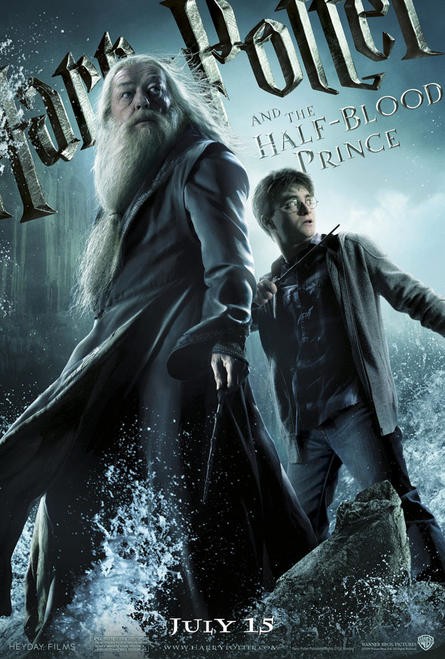
Harry Potter & The Half-Blood Prince
Thanks to a media preview screening, I’ve already seen Harry Potter and the Half-Blood Prince, which officially opens with midnight showings on Wednesday.
It’s safe to say this film is highly anticipated: Across the lobby, fans already were queueing up for another screening five hours later, at 7 p.m., one of those first-come-first-seated promotional showings. And to be honest, they’ve really been waiting longer than that; the new HBP movie’s opening date got pushed back from last fall. So hardcore Potterheads have had about nine months to crank up their squee levels.
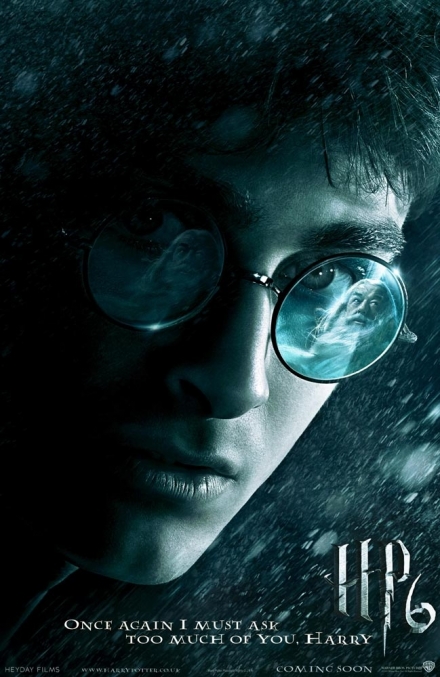 Number six in the series is the darkest yet, as the boy wizard’s fan base surely knows. It pays a good deal of attention to certain key aspects of the J.K. Rowling book, while other parts of the original story, as always, must fall by the wayside — even with a running time of two and a half hours, something’s gotta go.
Number six in the series is the darkest yet, as the boy wizard’s fan base surely knows. It pays a good deal of attention to certain key aspects of the J.K. Rowling book, while other parts of the original story, as always, must fall by the wayside — even with a running time of two and a half hours, something’s gotta go.
Overall, I felt this sixth film compares favorably with the three more recent entries in the series. (The first and second installments of Harry Potter, directed by Chris Columbus, were huge box-office successes — but were blown away artistically by No. 3, Alfonso Cuaron’s critically acclaimed The Prisoner of Azkaban, which set the standard for all Potter movies thereafter.)
What will Rowling purists quickly spot as hits and misses in Half-Blood Prince?
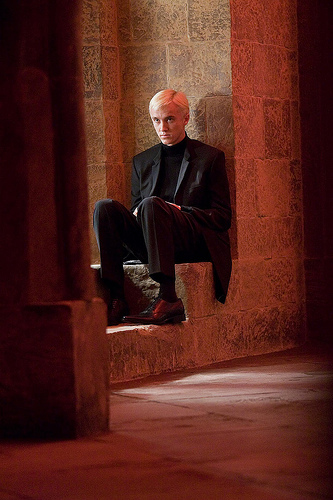
My major complaint is that I’d have loved to see the book’s opening chapter dramatized. That chapter, “The Other Minister,” discusses a series of disasters in the Muggle world, which are really caused by rampaging Death Eaters, followers of the wizarding world’s evil Lord Voldemort. I was hoping for a couple of scenes with the Muggle Prime Minister (who simply would have to have been played by Michael Sheen, Tony Blair’s cinematic alter ego) and the new Minister of Magic, Rufus Scrimgeour (who will be played in the next Potter film by Bill Nighy).
However, screenwriter Steve Kloves (back after a hiatus from Order of the Phoenix) and director David Yates (returning for his second Potter film in a row) chose to show us, rather than tell about, one of the disasters: a new bridge that inexplicably collapses in a freak storm, thanks to Bellatrix Lestrange (Helena Bonham Carter) and a couple of other Death Eaters, the creepy Carrow siblings.
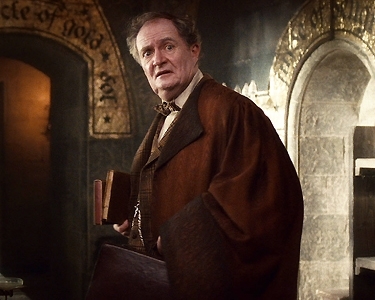
And instead of giving us scenes from the hilarious chapter with Hogwarts headmaster Albus Dumbledore retrieving Harry from the Dursleys’ home, we get Harry in a railway coffee shop, flirting awkwardly with a comely young waitress before Dumbledore (Michael Gambon) whisks him off to persuade Horace Slughorn (Jim Broadbent) to return to Hogwarts as the new Potions professor.
Another big departure: After Harry is deposited at the Weasleys’ home, The Burrow, a fiery Death Eater attack makes it clear that no place is safe. In the book series, a similar attack happens at a Weasley family wedding. But that event happens not in Book 6, but early in Book 7, Harry Potter and the Deathly Hallows. So it seems safe to assume the wedding’s not going to happen in the film series, because the bride and groom don’t show up in this movie at all. Neither does the surly house-elf Kreacher, although he’ll surely appear in the movie version of Book 7.
Lovers of Quidditch will be happy to see one last airborne match in this installment. And as in the book, teenage hormones rampage through much of the film, with “snogging” and humorous romantic situations to leaven the increasingly darker themes of death and loss.
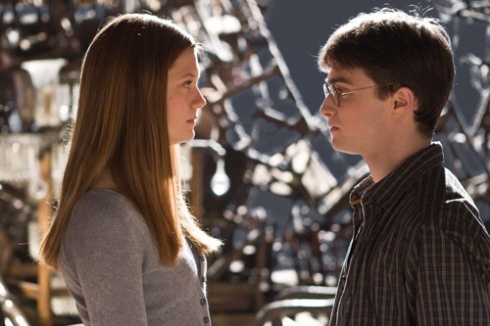
The leading trio of Harry Potter (Daniel Radcliffe), Hermione Granger (Emma Watson) and Ron Weasley (Rupert Grint) are joined by Ginny Weasley (Bonnie Wright), Ron’s sister who has grown up to be Harry’s love interest, and who gets much more screen time in this film than in the previous ones.
Luna Lovegood (Evanna Lynch) is happily daft as ever, and the lovelorn Lavender Brown (Jessie Cave) is all over her “Won-Won.” There’s a wonderful set-piece with the Weasley twins, Fred and George (James and Oliver Phelps), in their amazing Diagon Alley joke shop. Meanwhile, a solitary Draco Malfoy (Tom Felton) lurks miserably about, determined to carry out his secret mission for Voldemort and restore his family’s lost honor.
Other Hogwarts teachers, such as Minerva McGonagall (Maggie Smith), Severus Snape (Alan Rickman) and Rubeus Hagrid (Robbie Coltrane) get a few crucial scenes each, but I felt Snape in particular got short shrift in this film, considering his importance to the series. We never even see him teaching Defense Against the Dark Arts, formerly Harry’s favorite class at Hogwarts. (And has anyone else out there ever wondered what it would have been like if they’d cast Daniel Day-Lewis as Snape? He’s the only actor I can think of who just might have out-Snaped the amazing Rickman.)
Voldemort’s craven sidekick, Peter “Wormtail” Pettigrew (Timothy Spall), is fleetingly spotted in the “Spinner’s End” scene, which also introduces a badly miscast and horribly made-up Helen McCrory as Draco’s mum, Narcissa Malfoy. (Why, oh why didn’t they get Naomi Watts for that role?)

Frank Dillane
In his scenes as 11-year-old Tom Riddle, young Hero Fiennes-Tiffin (nephew of Ralph Fiennes, who plays Voldemort) holds his own with Gambon’s Dumbledore, projecting a youthful malevolence appropriate for the boy who will grow up to be the Dark Lord. It’s also worth noting that Riddle at age 16 is played by another scion of a British acting family: Frank Dillane, son of actor Stephen Dillane (who played Thomas Jefferson in HBO’s John Adams miniseries). The two young actors bear enough resemblance to each other that it becomes easy to believe this is the same boy at different ages.
When Harry and Dumbledore journey to the cave where Voldemort has hidden one of his Horcruxes — a personal relic containing a piece of his irretrievably damaged soul — Yates recreates the scene almost exactly as Rowling imagined it. And it is both dazzling and fearsomely scary. Even when you know exactly what’s coming, the moment when an Inferius grabs Harry is still enough to make you gasp.
It does not do to be too much of a purist with these movies; after all, watching a film is not the same experience as reading a book. But seeing what Yates can do with such a powerful scene makes me wish again that he’d had the chance to direct the first two films as well. There were so many moments in this new film where I was completely, happily absorbed in the story — never mind that I know the entire plot inside out. That’s the mark of an adroit director.
Fortunately, we know Yates is shooting the final two Potter movies. Deathly Hallows is already in production and will be released in two parts, in 2010 and 2011. With twice as many hours to tell the last story, even diehard fans may be satisfied that justice will be done to their beloved wizard’s saga.
As one of those annoying people who would rather read a good book than do just about anything else, including work for a living, I have finally found a way to make my obsession semi-respectable: I am anointing myself as a book blogger.
To celebrate, here is the first of what I hope will be a series of blog tours with interesting authors. (And muchas gracias to my baby sister, the blogger known as the Little Fluffy Cat, for recently educating me as to what a “blog tour” actually is.) I’ll continue to write about other subjects, too. But this venture promises to be fun for me, and I hope it will be for you, too.
With that in mind, let’s start the fun now.
•

Sarah Bird
My inaugural blog-tour Q&A is with award-winning Austin novelist Sarah Bird, the author of one of my all-time favorites, The Yokota Officers Club (Knopf). Her seventh and most recent novel, How Perfect Is That, has just been reissued in paperback (Pocket Books, $15). Sarah is a regular columnist for Texas Monthly, and she is also [full disclosure here] a personal friend.
Backstory: I profiled Sarah for The Dallas Morning News shortly after Yokota was published in 2001. We spent a 110-degree summer day toodling around Austin, hitting some of her personal landmarks such as the LBJ Library, the University of Texas, and Seneca House, the real-life Nueces Street co-op that was the setting for Sarah’s first comic novel, Alamo House.

How Perfect Is That
Seneca House makes a major reappearance in How Perfect Is That, which The News called “a perfect, curl-up-with-a-margarita splash of summer fun…wickedly good.” Its heroine, if you can call her that, is Blythe Young, a trailer-trash Cinderella who married up — way up — into Austin society, snagging Henry “Trey” Biggs-Dix III, “a scion of one of America’s wealthiest dynasties.” But now the marriage is kaput and Blythe has been pre-nupped into poverty. She’s trying to maintain her social standing and make a living as a high-end caterer, and she’s failing miserably. How miserably? She can’t afford to get a Pap smear. And her plight gets worse, and skankier, and funnier, by the page.
Here’s the fabulous Sarah Bird, on How Perfect Is That and other writerly topics:
Now that How Perfect Is That is out in paperback, is it safe for you to reveal to us how its hardcover readers reacted to it? Was there a love-hate thing going on there?
Joyce, hello! What a doll baby you are, in general, but in particular for allowing me to jump into your digital world like this.
It’s quite interesting for me to talk about a book that was published a year ago. In that year, I’ve read all the reviews — I am definitely not one of those lofty writers who can hold themselves above the fray and ignore reviews — and had lots and lots of discussions about How Perfect Is That.
The one piece of the reaction to this book that is utterly different from any of my others is how stunningly polarized it is. More than anything else I have ever written, How Perfect does seem to be a love-it or hate-it read. This came across very dramatically for me in following the reviews on Amazon. Until yesterday, I had no — none, zero — four- or three-star reviews. All fives, twos and ones. (Oh, Joyce, I don’t think I’ve ever gotten one star before, and reading those one- and two-starrers, I did wish I were an above-the-fray author who never bothered herself about such matters.)
This dramatic lack of middle ground has led me to two conclusions: One, if a book is foisted upon a reader as a “comic novel,” if the foisterer promises that this will book will make you lose bladder control, and if the reader then does not find the book to be a laugh riot, that reader will be mightily irritated. Irritated enough to let Amazon know about it. Apparently, novels that are held out to be comic — unlike thrillers, romance, or even general mid-list literary fiction — don’t miss by inches. They either synch up with a reader’s sensibilities, what he or she thinks is funny, and are a dead-on hit, or they don’t work at all.
Second conclusion: It can be a challenge to read about a character who makes moral choices that you, the reader, wouldn’t. My “heroine,” Blythe Young is a user and an abuser. A striver and a conniver. A climber and whatever rhymes with –imer. Bad two-timer? Annoying street-mimer? All right, not the last two, but she is a scoundrel. The big question hanging over the book is, “Can she be redeemed?” The bigger question that I was addressing was, “Can she be really funny in the process?”
A few months ago, when I needed to make myself feel confused and depressed, I did a bit of self-Googling. A series of random links led me to a site that proposed that my first novel, published in 1986, Alamo House: Women Without Men, Men Without Brains, was the first chick lit book ever. Who knows? Though someday it might be remarked that How Perfect Is That was the first in another line: Bitch Lit.
Did your male readers react differently to Blythe than did females?
I’m going to do a dangerous thing and generalize: Females are much more likely to demand that a protagonist be someone she can relate to. Not necessarily like, but someone who would make pretty much the same moral choices that she would. I’d say that this is even truer if the protagonist and the author are female.
Why did you use your old Austin co-op’s real name, Seneca House, this time around — why not make it “Alamo House” again?
Yay! Thank you, Joyce, for noticing. When I wrote Alamo House, I used the name of the co-op where I lived while going to graduate school at UT, Seneca House. Norton published that book and, fearing libel suits, had me expunge all ties to the real world. They told me I could call the co-op either Magnolia House or Kudzu House. Okay, that last is a joke, but New York at that time, early eighties, had a much harder time understanding that Texas was not the South.
I’ve was delighted that Knopf had no problems allowing me to use the real name of my old co-op, which I have a great deal of affection for.
Just exactly how much did you know about Austin high society, prior to writing How Perfect Is That? And how much did you have to exaggerate said society for comic effect?
How Perfect Is That involved a different sort of research than I’d ever done before. For the high-society sections, I had to go to school on fashion, shoes, handbags, which designers are in, which are out, what each one signifies, the whole semiotics of apparel. Fortunately, many kindhearted souls in high places helped me with the high-society research by sharing their worlds with me, allowing me to glimpse lives that are a round of charity galas, private jets, and Dom Perignon by the crate.
The low-society stuff was much easier since, like my heroine, I did actually live in a UT co-op boarding house called Seneca House while I was getting my master’s at the University of Texas. But in that day and age, it housed female graduate students. It has since morphed into a co-ed, mostly undergraduate, sometimes feminist, mostly vegan, generally activist house which the current residents were kind enough to allow me to visit several times.
So both worlds had their own anthropology, and getting the anthropology right is one of my chief joys in writing. Mostly, though, I found it hilarious imagining what it would be like to have Barbara Bush as your mother-in-law. What a weekend with that whole crew might be like.
Pretty much everything was exaggerated.
Do you still get nervous before book signings? Are you finding that using “new media” (such as blog tours) has made promoting your books any easier?
Such a timely question since this is, literally, my very first day of book blogging ever and it is making me oddly nostalgic for the old ways and old days. Alamo House was published in the mid-eighties at about the same time that readings and signing started becoming popular. Prior to that, practically the only writers who toured had won Pulitzers. It just wasn’t that common. So it took a while for me to get comfortable with this new public aspect of writing.
It started to fall into place for me when I started to think of signings as parties and I was the hostess. It truly all clicked for me with this book. Because of my heroine’s fondness for all cocktails — be they grain-, fruit-, or chemical-based — I was inspired to ask Tito’s Vodka to be my sponsor. They agreed, and my mantra became: A Buzz With Every Book.
Wow, Joyce, end of “nerves” for everyone. And, P.S., my apologies to your readers who came to signings in any non-indie bookstore, because, gosh darn it, those big corporations just could not get into my Buzz With Every Book program and let me serve cocktails.
So, at this point I don’t know what effects new media will have. I am kind of sad, though, about anything that keeps people from getting out of their houses and having a cocktail.
Can you talk about the new novel you’re working on? How about the film adaptation of Flamenco Academy — is it really happening?
Yes, I can! I am ecstatic that Knopf — my dream publisher, home to my dream editor — has given me a contract for the next one which should be out Fall 2010. It is about a single mom facing the prospect of an empty nest. She’s worried about her daughter leaving home, and flat-out terrified that her only child won’t go to college.
Joyce, here’s what I say about all film projects I have ever been involved with: Don’t buy your popcorn until you’re in the lobby. I would love for that novel [The Flamenco Academy] to become a film. It’s been optioned by a wonderful producer, Anne Walker, who produced most of Rick Linklater’s films. I had a grand time adapting it. And now the script is in the hands of the gods.
Joyce, come back to Austin. We’ll eat enchiladas at Curra’s.
Sarah Bird is the author of six previous novels, and writes a regular column for the magazine Texas Monthly. Her features appear frequently in other magazines, including Ladies Home Journal and Good Housekeeping, and she is also a contributor to Salon.com. She lives in Austin, Texas.


